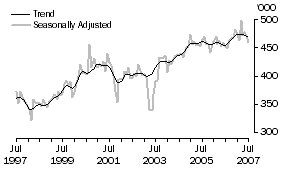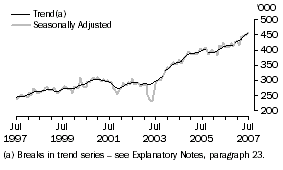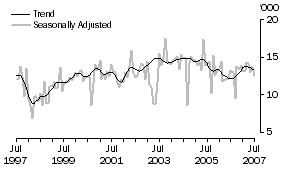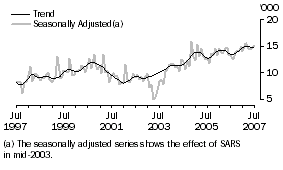MAIN FEATURES
SHORT-TERM VISITOR ARRIVALS
In trend terms, short-term visitor arrivals to Australia during July 2007 (468,300 movements) decreased 0.5% compared with June 2007 (470,600 movements). Currently, short-term visitor arrivals are 3.0% higher than in July 2006.
SHORT-TERM VISITOR ARRIVALS

The following table presents the top ten source countries (based on original estimates) for short-term visitor arrivals during July 2007. Seasonally adjusted and trend estimates are also presented for these countries, along with the percentage change in trend compared with June 2007 and July 2006.
Short-term Visitor Arrivals, Major Source Countries - July 2007 |
|  |
 | Trend | Seasonally Adjusted | Original | Jun 07 to Jul 07 | Jul 06 to Jul 07 |  |
 | '000 | '000 | '000 | Trend % change | Trend % change |  |
|  |
| New Zealand | 96.7 | 89.8 | 104.6 | -0.4 | 10.4 |  |
| Japan | 46.8 | 48.6 | 47.9 | -0.1 | -12.2 |  |
| United States of America | 37.8 | 37.7 | 45.6 | -0.5 | 0.1 |  |
| United Kingdom | 56.5 | 55.8 | 42.6 | -1.4 | -2.9 |  |
| China | 28.4 | 28.3 | 33.1 | -0.4 | 6.8 |  |
| Korea | 22.3 | 22.4 | 22.8 | 0.4 | 1.3 |  |
| Singapore | 21.5 | 20.6 | 17.6 | -1.6 | 0.5 |  |
| Hong Kong | 12.2 | 11.3 | 13.6 | -1.3 | -6.0 |  |
| Germany | 13.1 | 13.3 | 13.6 | 0.8 | 7.8 |  |
| Malaysia | 13.3 | 12.6 | 11.1 | -1.2 | 9.1 |  |
|  |
SHORT-TERM RESIDENT DEPARTURES
In trend terms, short-term resident departures (455,100 movements) increased by 0.9% compared with June 2007 (451,000 movements). Short-term resident departures are currently 7.3% higher than in December 2006, when a trend break was introduced.
SHORT-TERM RESIDENT DEPARTURES

The following table presents the top ten destinations (based on original estimates) for short-term resident departures during July 2007. Seasonally adjusted and trend estimates are also presented for these countries, along with the percentage change in trend compared with June 2007 and July 2006.
Short-term Resident Departures, Major Destinations - July 2007 |
|  |
 | Trend | Seasonally Adjusted | Original | Jun 07 to Jul 07 | Jul 06 to Jul 07 |  |
 | '000 | '000 | '000 | Trend % change | Trend % change |  |
|  |
| New Zealand | 76.9 | 77.7 | 70.6 | 1.1 | 7.2 |  |
| United Kingdom | 34.9 | 33.4 | 42.6 | 1.1 | -0.8 |  |
| United States of America | 38.2 | 38.8 | 34.7 | -0.4 | 2.9 |  |
| Thailand | 33.4 | 34.0 | 34.5 | 1.7 | 38.3 |  |
| Indonesia(a) | 22.8 | 22.7 | 27.7 | 0.3 | 48.9 |  |
| Singapore | 19.4 | 19.6 | 21.2 | 2.8 | 14.5 |  |
| Fiji | 16.3 | 16.2 | 18.4 | 1.9 | -5.1 |  |
| China | 24.5 | 24.0 | 18.3 | 0.4 | 13.4 |  |
| Malaysia | 14.8 | 15.1 | 16.0 | 0.1 | 9.9 |  |
| Hong Kong | 17.4 | 16.9 | 14.3 | 0.4 | 5.0 |  |
|  |
| (a) Break in trend series from December 2006. |
PERMANENT AND LONG-TERM MOVEMENTS
There were 10,000 permanent (settler) arrivals to Australia during July 2007, a decrease of 2.9% compared with July 2006 (10,300 movements). People born in New Zealand accounted for the largest proportion of settlers (21%), followed by people born in the United Kingdom (17%) and China and India (each 9%).
There were 6,320 Australian residents departing permanently from Australia during July 2007, an increase of 11.2% compared with July 2006 (5,690 movements).
Statistics on overseas arrivals and departures relate to the number of movements of travellers rather than the number of travellers. Care should be taken when using long-term movements data as it is known that some individuals who travel multiple times in a year are counted each time they cross Australia's borders (see paragraph 5 of the Explanatory Notes). Long-term movements in this publication are not an appropriate source of migration statistics. For further information refer to Australian Demographic Statistics (cat. no. 3101.0) and Information Paper: Statistical Implications of Improved Methods for Estimating Net Overseas Migration, Australia, 2007 (cat. no. 3107.0.55.005).
SHORT-TERM TRAVEL - MALAYSIA
Short-term visitor arrivals
Trend estimates provide the best method to analyse the underlying direction of the short-term visitor arrivals series for Malaysia. Over the ten year period ending July 2007 the trend estimates, while experiencing fluctuations, have maintained a relatively stable level. The large dip in the series, from August 1997 to April 1998, coincided with the Asian financial crisis between mid-1997 and 1998. The high point during the ten year period was in June 2003 (14,900 movements) and the low point was in April 1998 (8,900 movements). Currently, the number of movements is 9% higher than in July 2006.
MALAYSIA, Short-term Visitor Arrivals

In original terms, in the year ended July 2007 short-term visitor arrivals from Malaysia represented 3% (156,700 movements) of all short-term visitor arrivals to Australia. This was the same as the proportion for the previous twelve months (152,100 movements)
In the year ended July 2007, short-term visitor arrivals from Malaysia stated holiday (49%) as the main reason for journey, followed by visiting friends and relatives (20%), education (10%) and business (9%). In comparison the main reasons for journey for all short-term visitors to Australia were holiday (51%), visiting friends and relatives (20%), business (11%) and education (5%). The median age of short-term visitors from Malaysia was 38 years (39 years for all short-term visitor arrivals), and the median duration of stay was 10 days (also 10 days for all short-term visitor arrivals).
Victoria (29%), New South Wales and Western Australia (each 24%) and Queensland (16%) were the main states/territories of intended stay for short-term visitor arrivals from Malaysia in the year ended July 2007. The main destinations for all short-term visitor arrivals to Australia were New South Wales (39%), Queensland (28%), Victoria (18%) and Western Australia (9%).
Short-term resident departures
Trend estimates provide the best method to analyse the underlying direction of the short-term resident departures series for Malaysia. Over the ten year period ending July 2007 trend estimates have fluctuated. While the series generally recorded growth, there was a continuous drop in resident departures to Malaysia between late 2000 and early 2002. Events that may have influenced the decline in numbers of resident departures during this period were the Olympic Games, held in Sydney in September 2000, the low Australian dollar and the terrorist attacks in the United States of America on 11 September 2001. The high point during the ten year period was in February 2007 (14,900 movements) and the low point was in September 1997 (7,800 movements). Currently, the number of movements is 10% higher than in July 2006.
MALAYSIA, Short-term Resident Departures

In original terms, in the year ended July 2007 short-term resident departures to Malaysia represented 3% (174,300 movements) of all short-term resident departures from Australia. This was the same as the proportion for the previous twelve months (163,600 movements).
In the year ended July 2007, short-term resident departures to Malaysia stated holiday (49%) as the main reason for journey, followed by visiting friends and relatives (22%) and business (16%). In comparison the main reasons for journey for all short-term visitors to Australia were holiday (48%), visiting friends and relatives (24%) and business (15%). The median age of short-term resident departures to Malaysia was 42 years (41 years for all short-term resident departures), and the median duration of stay was 13 days (15 days for all short-term resident departures).
STATISTICAL SIGNIFICANCE
The above presentation of movements in estimates does not take into account whether the change in movement is statistically significant. Care should be taken when interpreting the impact of numeric and/or percentage change. Please see the Standard Errors section of this issue for more detail.
 Print Page
Print Page
 Print All
Print All